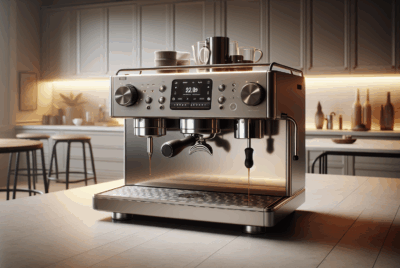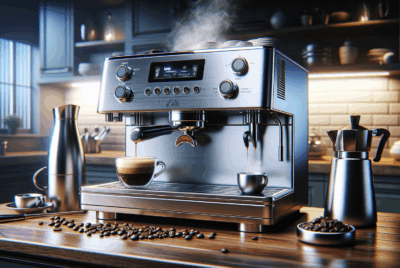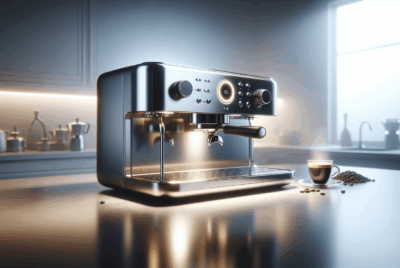Can Normal Coffee Be Made in an Espresso Machine: Exploring Brewing Techniques
As an Amazon Associate, I earn from qualifying purchases, at no additional cost to you. Disclaimer
I’ve often wondered if I could make regular coffee using my espresso machine. It seemed like a practical idea, given that an espresso machine always sits on my counter.
Yes, it’s possible to make a coffee similar to regular drip coffee in an espresso machine, but the method and results might differ.

By adjusting the grind size and tweaking the water amount, I can brew a longer shot, which mimics regular coffee more closely. This type of coffee is sometimes called an “Americano.”
An Americano involves adding hot water to a shot of espresso, giving it a taste similar to that of traditional drip coffee.
Experimenting with different techniques and settings on the espresso machine can satisfy both espresso lovers and regular coffee drinkers in the household.
Whether I’m in the mood for a quick espresso shot or a fuller cup of coffee, knowing my options lets me enjoy the best of both worlds.
Understanding Coffee Types
When it comes to coffee, there are several types and styles to explore. This part will focus on comparing regular coffee and espresso, as well as understanding the two main coffee bean types: Arabica and Robusta.
Regular Coffee Vs. Espresso
I’ve always found it interesting how regular coffee and espresso differ so much. Regular coffee is typically made using a drip brew method, which involves hot water slowly seeping through coffee grounds.
This process results in a lighter flavor and texture.
On the other hand, espresso is brewed by forcing hot water through tightly packed coffee grounds. This results in a thicker and more concentrated drink. It also has a richer flavor and more intense aroma. The difference in brewing time and pressure leads to these unique characteristics.
Espresso uses a specific grind that’s finer than what you find in regular coffee. The equipment used for espresso is often more specialized, like espresso machines, which create the necessary pressure to extract flavors fully.
Arabica and Robusta Beans
Arabica and Robusta beans are the most common coffee bean types I encounter. Arabica beans are known for their smooth and mild flavor. They grow at higher elevations and have a wider range of flavor profiles, from fruity to nutty.
Arabica is often favored for its sweet taste and complex aromas.
In contrast, Robusta beans have a stronger, more bitter flavor. They contain more caffeine, making the flavor more intense. Robusta plants are hardy and grow in various environments, offering a more robust taste.
I’ve noticed that Arabica is often used in specialty and high-quality coffee. Robusta is typically found in espresso blends, adding a depth and strength to the brew, thanks to its bold flavor. This knowledge helps me choose the right beans based on the coffee I want to make.
Espresso Machines Explained
Espresso machines are complex devices that use pressure to brew coffee. They consist of key components like the boiler and pump, which work together to extract flavor-rich espresso shots. Understanding the mechanics and the different types available helps in choosing the right machine for specific needs.
The Mechanics of Espresso Machines
In an espresso machine, pressure is fundamental. It forces hot water through finely-ground coffee, extracting the flavors and oils to create espresso. Most espresso machines have a boiler, which heats the water to the ideal temperature.
The pump is responsible for generating the pressure needed, usually around 9 bars, which is crucial for a good espresso.
Portafilters hold the coffee grounds. They are locked into the machine to ensure water channels through them evenly. Many machines also feature steaming wands for frothing milk, adding another layer of functionality. Each part works collaboratively, making espresso machines both intricate and effective in brewing high-quality coffee.
Types of Espresso Machines
Espresso machines come in various types, each suited for different preferences and needs. Manual machines require a bit more skill, as I have to control the brewing process from start to finish.
Semi-automatic machines provide more convenience, with automation for tasks like water flow control, yet still allow some manual input.
Automatic machines take care of most of the brewing steps, delivering consistent results with minimal effort.
For ultimate convenience, super-automatic machines handle everything, from grinding beans to frothing milk. They are perfect for those who prioritize ease of use without sacrificing quality.
Brewing Espresso Vs. Drip Coffee

When comparing espresso and drip coffee, the brewing method and grind size play vital roles. Each method creates a unique taste and coffee experience, suited to individual preferences.
Brewing Method Comparisons
In espresso brewing, I use a process called pressure extraction. The machine forces hot water through finely ground coffee at high pressure. This method creates a rich, concentrated flavor. An espresso’s bold taste comes from this intense process, which extracts flavors quickly.
Drip coffee, on the other hand, relies on drip brewing. Here, water passes slowly through coffee grounds, usually in a drip coffee maker.
The process is gentler, creating a smoother taste and allowing more of the coffee’s aromatic oils to be released. The longer contact time with the water results in a more subtle flavor. These differences highlight the unique qualities of each brew.
Grind Size and Coffee Quality
Grind size heavily influences the flavor and quality of coffee. For espresso, I need a fine grind; it helps with the fast, high-pressure process. If the grind is too coarse, the espresso will taste weak because the water flows through too easily.
For drip coffee, a medium grind works best. This allows water to extract the coffee’s flavors at a steady pace. Using too fine a grind can over-extract, making the coffee bitter. Meanwhile, too coarse a grind might result in weak coffee. Managing grind size ensures the best flavor from each method.
Crafting Coffee Drinks

Crafting coffee drinks with an espresso machine opens up a world of possibilities. From classic espresso-based drinks to creative ways of brewing regular coffee, there are various techniques to explore.
Popular Espresso-Based Drinks
I love making espresso-based drinks because they offer rich flavors and diverse choices. An espresso shot is the base for many drinks; it’s concentrated coffee that sets the stage for flavor.
My go-to is the Americano. It’s simple to make—just add hot water to an espresso shot. This gives a smoother taste while maintaining that espresso kick.
I often make lattes and cappuccinos too. Both require skills in frothing milk. To create a latte, I pour steamed milk over a shot of espresso. Cappuccinos use equal parts of espresso, steamed milk, and foam. It’s all about finding the right milk texture for each drink.
For a lungo, I just let the espresso brew longer, increasing the brewing time and water volume for a more subtle flavor.
Making Regular Coffee with an Espresso Machine
While espresso machines are designed for certain types of coffee, it is possible to make a regular coffee. For an iced coffee, I often pull a double shot and pour it over ice, which is a refreshing twist.
To mimic a regular drip coffee, I start with more water than usual in an Americano style, essentially diluting the espresso to the desired strength. The key is managing the brewing time and water volume to imitate a standard coffee brew. By adjusting these factors, achieving a coffee-like beverage with robust flavor is entirely doable.
Optimizing Flavor and Extraction

I focus on balancing flavors and extraction times when making coffee in an espresso machine. Key factors include the brewing parameters and choosing the right roast level paired with suitable water temperature.
Adjusting Brewing Parameters
When making coffee in an espresso machine, I adjust brewing parameters such as grind size and extraction time. Using a coarser grind helps to avoid over-extraction, preventing the coffee from becoming too bitter. I find that a grind size similar to sea salt often works well.
Extraction time is crucial. Typically, espresso takes about 25 to 30 seconds to brew. Adjusting this time can help in achieving a richer flavor. If the coffee tastes sour, I might increase the extraction time a bit. If it’s too bitter, a shorter brew time may be necessary.
The Impact of Roast Level and Water Temperature
Roast level greatly influences the flavor profile. I choose a medium roast for a balance of flavors and highlight the coffee’s natural taste. Dark roasts can sometimes be overly bitter in an espresso machine.
When it comes to water temperature, I aim for around 195°F to 205°F. This range enhances extraction without burning the coffee.
Consistent temperature ensures that I capture the full taste of the coffee beans. Too hot and the coffee might taste burnt; too cold and it could be flat and under-extracted.
Machine and Coffee Bean Maintenance

Taking care of your espresso machine and coffee beans is crucial for a great morning cup. Regular cleaning keeps your machine running smoothly, while proper storage of coffee beans ensures freshness.
Regular Cleaning and Descaling
Cleaning your espresso machine regularly is important for making both normal coffee and traditional espresso. I follow a cleaning schedule that includes both daily tasks and more thorough monthly maintenance.
Every day, I wipe down the exterior, clean out the coffee grinder, and keep the drip tray free of water and debris.
Every month, I make sure to descale the machine. Descaling removes mineral buildup from the water, which can affect taste and machine performance. I use a mix of water and a commercial descaling solution, following the manufacturer’s instructions closely.
Keeping the espresso machine clean ensures good coffee every time, whether you’re making French press-style or espresso coffee. Just a few simple steps can make a big difference.
Storing Coffee Beans
Coffee enthusiasts like me know that storage is key to keeping coffee beans fresh.
I make sure to store my arabica coffee beans in an airtight container. This helps keep out moisture, light, and air, all of which can alter taste and aroma.
I avoid keeping my beans for too long. Buying smaller amounts more often ensures better flavor for my morning cup.
Whether it’s for espresso coffee or normal coffee, fresh beans matter. Using a proper container helps maintain their quality.
For grinding, I use a coffee grinder just before brewing. This preserves the rich flavors and aromas, important for both everyday coffee and traditional espresso.
Frequently Asked Questions
In exploring whether an espresso machine can brew regular coffee, I’ve looked at how coffee beans and grind levels impact flavor. I also consider the role of brewing pressure and potential modifications needed for machines like Breville.
What is the difference between espresso beans and regular coffee beans?
Espresso beans are often roasted darker, which brings out bold flavors.
Regular coffee beans can be anywhere from light to dark roasts. The choice of roast affects the taste.
How does the grinding level of coffee affect espresso versus regular coffee brewing methods?
Espresso requires a fine grind to allow water to pass through quickly under pressure.
Regular coffee brewing uses coarser grinds for slower water flow and better extraction.
Is it possible to prepare a standard cup of coffee with an espresso machine specifically designed for espresso?
An espresso machine can brew something similar to regular coffee, though it might not taste exactly the same. Adjustments may be needed in grind size and water volume.
What are the recommended types of coffee grounds to use in an espresso machine for best flavor?
For the best sound flavor, use medium to dark roast beans ground finely. This helps in balancing taste and acidity when brewing in an espresso machine.
Can the pressure-based brewing method of espresso machines affect the taste of regular coffee?
Yes, the high-pressure method impacts flavor by extracting oils and flavors quickly. This can result in a stronger, more concentrated taste than drip coffee.
What kinds of modifications are necessary to brew a traditional cup of coffee using a Breville espresso machine?
To brew regular coffee on a Breville, you might need to use more water and a coarser grind. These adjustments help mimic the drip coffee brewing process.



